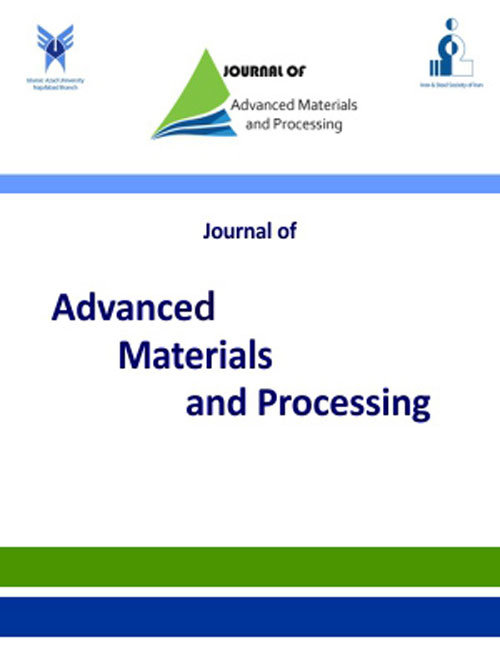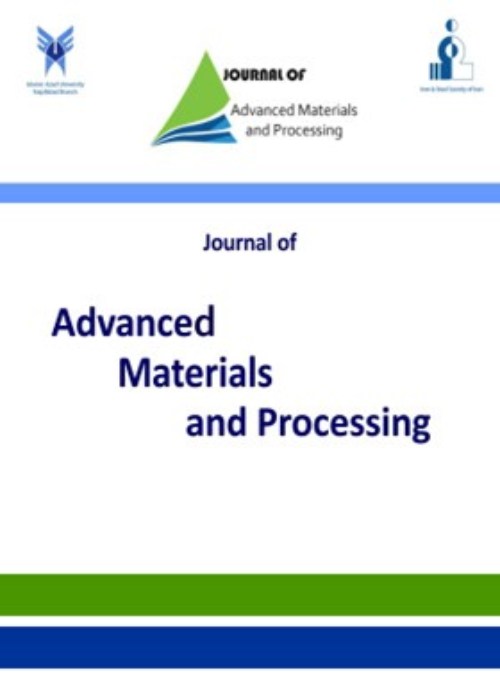فهرست مطالب

Journal of advanced materials and processing
Volume:3 Issue: 4, Autumn 2015
- تاریخ انتشار: 1394/10/30
- تعداد عناوین: 6
-
-
Pages 3-10Equal channel multi angular pressing (ECMAP) process is an efficient method to enhance the productivity of ultra-fine grained (UFG) materials by increasing process continuity and as a result decreasing the process required time. Comparing repetitive ECAP method, in the same period, the number of passes can be done by ECMAP. In this article, ECMAP of AL strips in two typical annealed and as received conditions were studied, and route C was selected as multi pressing route. Values of equivalent plastic strain (PEEQ) and micro-hardness in the cross section of ECMAPed strips were obtained both by FE simulations and practical tests, correspondingly. These values were also used for obtaining the inhomogeneity of produced ECMAPed strips. Furthermore, mechanical property for both as received and annealed strips before and after pressing was studied experimentally. Also, load-displacement curve during the ECMAP process was obtained by finite element method (FEM). For FEM results validation, PEEQwas calculated by the analytical method, too. Results show that there is good conformity between FE, analytical, and practical results.Keywords: Aluminum Sheet, Severe Plastic Deformation, ECMAP, Finite Element Method
-
Pages 11-25The purpose of this study was to optimize the thickness of anodizing Aluminum coatings processed under pulse current mode through Design of Experiments (DOE) method. Thickness measurement, polarization and electrochemical impedance spectroscopy were employed to take thickness and corrosion behaviors of the anodized coatings into consideration. Also, field-emission scanning electron microscopy (FE-SEM) was utilized to characterize the surface morphology of the coatings. It was found that thickness of the anodized coatings strongly depends on various parameters among which time, temperature and pulse current parameters (like current density limit, frequency and duty cycle) were considered in the present study. Analysis of variance (ANOVA) was used for estimating the coating thickness. Experimental results showed the maximum value for coating thickness was 62 µm being attained at the maximum and minimum current density of 6.28 and 1.55 A/dm2, a frequency of 150.5 Hz, time of 51 min, duty cycle of 81.5% and the bath temperature of 13.5oC. Also, FE-SEM observations of the surface of anodized coatings showed that this optimum condition leads to a lower porosity amount. Polarization measurements showed that this lower porosity amount causes an increase in corrosion resistance of the anodized coatings.Keywords: Nanoporous Anodized Aluminum Pulse Current Corrosion Behavior DOE
-
Pages 26-33The synthesis of iron oxide nano-particles by direct thermal decomposition was studied. Simultaneous thermal analysis and Fourier transform infrared spectroscopy results confirmed the formation of iron-urea complex and disclosed iron oxide formation mechanism. Calcination of the iron-urea complex at 200°C and 250°C for 2 h resulted in the formation of maghemite along with hematite as a second phase. X-ray diffraction (XRD) results revealed that increment of iron-urea complex calcination temperature led to the augmentation of hematite to maghemite ratio. Field emission scanning electron microscopy (FE-SEM) and transmission electron microscopy (TEM) results showed that the average particle size was around 38nm for the sample calcined at 250°C for 2 hrs. The anode body was doctor bladed using primary powder with polyvinylidene difluoride and graphite. Galvanostatic charge–discharge cycling showed a reversible capacity of 483 mAh g-1 at 100 mA g−1 current density. The reason for this competent performance was thought to be dependent upon the particle sizes.Keywords: Iron oxide Li, ion battery Anode Thermal decomposition Nanoparticles
-
Pages 34-50Production of lightweight metals with a higher strength to weight ratio is always the main goal of researchers. In this article, the equal channel multi angular pressing (ECMAP) process as one of the most appealing severe plastic deformation (SPD) methods for production of ultra-fine grained (UFG) materials is studied. Two main routes A and C were investigated by finite element method (FEM) and compared with each other from different perspectives. ABAQUS commercial software was used to evaluate the maximum strain, maximum required force, and strain inhomogeneity index in both routes and the obtained FEM results were verified by both theoretical calculations and experimental tests. It is inferred that although equivalent plastic strain (PEEQ) in route A is higher than that in route C, the strain homogeneity as a quality factor for route C is higher. So, route C was selected for more investigation and optimization. Grey relational analysis was used as the optimization method. Geometrical parameters were taken as input variables and both inhomogeneity index and maximum required load were taken as objectives. Then, the suggested tests by full factorial method were simulated by FEM. After optimization, it was concluded that the best set up belongs to experiment number 20 in which the values of Φ1, ψ1 and ψ2 are 165°, 0° and 15°, respectively. Also, it was inferred that among geometrical parameters, die channel angle (Φ1) is the most effective parameter.Keywords: Al 1050 Ultra, Fine Grain ECAMP Grey Relational Analysis
-
Pages 51-64Zinc oxide (ZnO) nanorods (NRs) with various aspect ratios (by changing the growth time between 0-240 min) were synthesized using hydrothermal method and were investigated using X-ray diffractometry (XRD), scanning electron microscopy (SEM) and UV–Visible and photoluminescence (Pl) spectroscopies. It was found that growth time is directly related to the length, orientation and aspect ratio of the NR arrays. The optical transmittance of NR arrays indicated a regular decrement of average transmittance with increasing the length and aspect ratio of the NRs in the visible range. The porous ZnO nanorod grown for 240 min with the thickness of ∼ 1.56 µm and texture coefficient of 0.96 exhibits some interesting properties like average visible transmittance of ~ 60%, refractive index of 1.34, packing density of 0.26 and lowest optical band gap. As the growth time increased, the PL intensity sustained a general weakening and a red-shift of UV-emission peak position. The UV-assisted photocatalytic degradation of 4-Nitrophenol (4-NP) of ZnO NRs were investigated. The considerable photocatalytic performance of ZnO NRs with highest aspect ratio was explained by its porosity and optical characteristics.Keywords: ZnO Nanorod Optical Constant Photocatalytic Activity
-
Pages 65-75α-Bi2O3 was synthesized via a hydrothermal method at 180 °C for 12 h in 1 (S1) and 2 (S2) M KOH aqueous solutions, using Bi(NO3)3·5H2O as raw material. The synthesized material was characterized by X-ray powder diffraction (XRPD) technique. The XRPD results indicated that by using 1M KOH aqueous solution, α-Bi2O3 was obtained with small fractions of β-Bi2O3, while 2M KOH solution resulted in pure α-Bi2O3. The α-Bi2O3 was crystallized in a monoclinic crystal structure with space group of P21/c. The size and morphology of the synthesized material was studied by field emission scanning electron microscopy (FE-SEM). The FE-SEM images showed that the obtained material had multigonal structures in micron dimensions. The synthesized material was tested as catalyst in Biginelli reactions and excellent performance was achieved in the optimized conditions. Experimental design was used to obtain optimized reaction conditions. Also, the optical properties of the obtained material were studied by ultraviolet visible (UV-Vis) diffuse reflectance spectrum (DRS).Keywords: Bi2O3, Hydrothermal Method, Experimental Design, Biginelli


